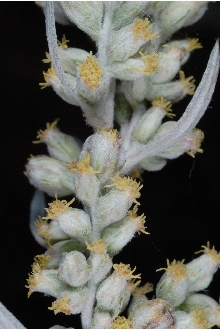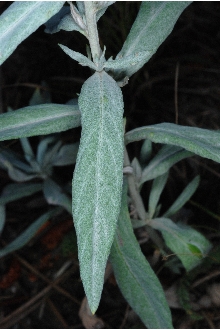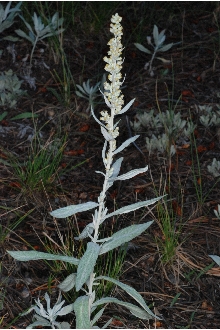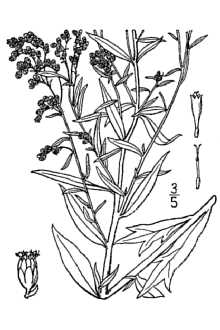White Sagebrush
Scientific Name: Artemisia ludoviciana Nutt.
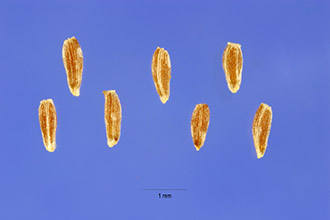
| General Information | |
|---|---|
| Usda Symbol | ARLU |
| Group | Dicot |
| Life Cycle | Perennial |
| Growth Habits | Forb/herbSubshrub, |
| Native Locations | ARLU |
Plant Guide
Alternative Names
Silver wormwood, white sagebrush, wild sage, prairie sage, wormwood, white mugwort, western mugwort, Louisiana sage, darkleaf mugwort, Mexican sagewort, Chihuahua sagewort, Garfield tea, lobed cudweed, man sage
Use
Ethnobotanic: Burning white sage and “smudge sticks” (the process of harvesting sage stems and tying the stem together into a “smudge stick”), was and is used for cleansing and purification (Gilmore 1977, Kindscher 1992). White sage or “man sage” was perhaps the most important ceremonial plant of the Cheyenne (Hart 1976). The sage was spread along the borders and on the altar in almost every ceremonial lodge (including the stone peoples lodge or sweat lodge) with the flowering end toward the fire. The leaves were burned as an incense to cleanse and drive away bad spirits, evil influences, bad dreams, bad thoughts, and sickness. A small pinch of baneberry (Actea rubra) was often mixed with it for this purpose. The smoke was used to purify people, spaces, implements, utensils, horses, and rifles in various ceremonies. The Lakota also make bracelets for the Sun Dance from white sage (Rogers 1980). The Cheyenne use the white sage in their Sun Dance and Standing Against Thunder ceremonies (Hart 1976). Other tribes who used white sage include the Arapaho, Comanche, Gros Ventre, Creek, Navaho, Tewa, and Ute (Nickerson 1966, Carlson and Jones 1939, Hart 1976, Thwaites 1905, Denig 1855, Elmore 1944, Robbins et al. 1916, Chamberlin 1909). Alfred Brousseau © Brother Eric Vogel, St. Mary’s College CalPhotos The Dakota and other tribes used white sage tea for stomach troubles and many other ailments (Gilmore 1977). The Cheyenne used the crushed leaves as snuff for sinus attacks, nosebleeds, and headaches (Hart 1976). The Crow made a salve for use on sores by mixing white sage with neck-muscle fat (probably from buffalo) (Hart 1976). They used a strong tea as an astringent for eczema and as a deodorant and an antiperspirant for underarms and feet. The Kiowa made a bitter drink from white sage, which they used to reduce phlegm and to relieve a variety of lung and stomach complaints (Vestal and Shultes 1939). Usually, they chewed the stem and leaves and swallowed the juice. The Kiowa-Apaches used a thin, sharp-pointed section of the stem as a moxa to relieve headaches or other pain (Jordan 1965). The Chinese also use an Artemisia species as a moxa to relieve pain such as arthritis. The Kiowa also used an infusion of white sage plants for the lungs, to cut phlegm, and for stomach trouble. The Mesquakie used the leaves as a poultice to “cure sores of long standing” (Smith 1928). They also made a tea of the leaves to treat tonsillitis and sore throat and a smudge of the leaves to drive away mosquitoes. The Omaha used the leaves in a tea for bathing and used the powdered leaves to stop nosebleeds (Gilmore 1913). Both the Pawnee and the Bannock women drank Artemisia ludoviciana tea during their moon time, or menstrual periods (Dunbar 1880). During the time that women lived away from their lodges in a menstrual hut, they drank the bitter tea made from either the leaves of white sage or the root of A. frigida (Gilmore 1930). The Blackfeet use the white sage in sweat-lodge rituals and as an ingredient in a stream vapor inhaled for respiratory problems. The “Giver of Breath” heals the ability to breathe with this powerful plant medicine. According to Moerman (1986) Artemisia ludoviciana was used for the following: • The Fox used a poultice of leaves to heal old sores, a burning smudge to drive away mosquitoes and to “smoke ponies when they have the distemper”, and an infusion of leaves to heal tonsillitis and sore throats. • The Omaha used the leaves as a bath for fevers and to prevent nosebleeds. • The Paiute used a decoction of the plant as a soaking bath to relieve aching feet, to heal stomachaches, as a poultice for rheumatism or other aches, as a poultice or compress for headaches, to stop diarrhea, in a sweatbath for rheumatism, and to relieve the itching and discomfort of rashes and skin eruptions. • The Shoshone took white sage for colds, coughs, headaches, stomachaches, as a compress for fevers, to stop diarrhea, as a physic, as a regulator of menstrual disorders, and for influenza. • The Washoe used white sage as a cooling, aromatic wash for headaches, colds, and coughs. The lactone glycosides, santonin and artemisin, are probably found in all Artemisia species and account for their anthelmintic properties (Moore 1979). Thujone, a terpene-like ketone and essential oil, is also found in the plant and may be responsible for some of its medicinal effects (Kinscher 1992). However, it is poisonous in large doses. The
Food
and Drug Administration classifies Artemisia as an unsafe herb containing “a volatile oil which is an active narcotic poison” (Duke 1985). Wildlife & Livestock: Sagebrush furnishes essential cover for many of the smaller desert animals (Martin et al. 1951). Its foliage and flower clusters constitute most of the diet of the sage grouse, and these parts together with the twigs bearing them are the primary source of food for antelope and mule deer.
Range
cattle also make good use of sagebrush as forage. Other mammals, which browse the foliage and stems, include jackrabbits, black-tailed rabbits, white-tailed rabbits, cottontails, chipmunks, gophers, ground squirrels, and various species of mice, prairie dogs, kangaroo rats, and white-throated wood rats. Elk and mountain sheep also browse on the foliage and twigs.
Status
Please consult the PLANTS Web site and your State Department of Natural Resources for this plant’s current status, such as, state noxious status and wetland indicator values.
Description
General: Sunflower Family (Asteraceae), Use soil moisture sensors to measure the soil moisture of White Sagebrush., White sage is a white-woolly, perennial herb 3-7 dm (1-2 1/4 ft) tall, with a strong odor of sagebrush, The stems are erect and often clustered from creeping rhizomes, The leaves are alternate, entire to irregularly toothed or lobed, 3-11 cm (1,25-4,5 in) long, up to 1,5 cm (9/16 in) wide, Flower heads are small tight greenish clusters among the leaves near the ends of the stems, White sage flowers from August through September, The fruits are dry, smooth, broadly cylindrical achenes, There are four subspecies of Artemisia ludoviciana (Hickman 1993),
Distribution
White sage occurs from east of the Cascade Mountains in Washington and Oregon, in California, north to eastern Canada, south to Texas and northern Mexico, and in Montana, Utah, Colorado, and in the Great Plains states. For current distribution, please consult the Plant Profile page for this species on the PLANTS Web site.
Establishment
Adaptation: White sage grows in riparian areas along both perennial and intermittent streams, in the sagebrush steppe, in both shortgrass and tallgrass prairies, and in semi-disturbed sites. It grows on dry, sandy to rocky soils below 3500 m. Most of the wild sages are abundant in their natural habitats. White sage and other Artemisia species can be propagated by seeds, by division of the rootstock, or by cuttings taken in the early summer (Kindscher 1992). Propagation from Cuttings: Artemisia ludoviciana spreads vigorously from rhizomes. Plants can easily be divided and replanted. • In greenhouse conditions, it is best to dig up and separate plants in late fall or winter. This is the “quiescent” period that follows seed maturation, and leaves are senescent (dried up and brown colored). • Split the plant clump into pieces by hand, then cut the plant into sections, each with one or more buds. • For dividing the whole plant, gently loosen the soil around the plant, taking care to not damage the roots, and then lift the plant gently with a pitchfork; shake off as much soil from the roots as possible. • Divide the plant into smaller pieces by hand, retaining only healthy, vigorous sections, each with new buds. • Replant the divisions as soon as possible. It is important the plants don’t dry out, so if replanting is delayed a couple of hours, dip the plants briefly in water and keep them in a sealed plastic bag in a cool, shady place until you are ready to plant them. • Cut back the old top-growth and replant the divided plant sections to the same depth as before. • When replanting, ensure that the roots are well spread out in the planting hole and the plant firmed in. Water newly planted divisions thoroughly; take care not to expose the roots by washing away soil when watering. • Plants should be planted in the full sun in a light, loose soil. Plants should be planted on 12-18” centers. • As plants are becoming established, the rooting zone needs to be kept moist. Propagation by Seed: When the soil has warmed to at least 45ºF (7ºC) in the spring, sow hardy Artemisia species where they are to flowers. • Seeds can also be sown in pots or seed trays and either out-planted in their final positions in late fall or over-wintered in a cold frame to be out-planted in spring. This technique is particularly useful in gardens with clay soil that is slow to warm up in spring. • The two main methods of sowing outdoors are broadcast and drills. For both, prepare the seedbed first by digging over the soil to one spade depth, then rake over and firm. • Broadcast Sowing: Sprinkle seeds thinly and evenly on the surface of the prepared seedbed and rake them in lightly. Label the seedbeds, then water the area gently but thoroughly with a fine spray. • Sowing in drills: Use either a trowel tip or the corner of a hoe, mark out shallow drill holes 3-6” (8-15 cm) apart, depending on the ultimate size of the plant. Sow seeds thinly and evenly by sprinkling or placing them along each drill at the appropriate depth. Carefully cover with soil and pack firmly. Label each row and water gently but thoroughly with a fine spray. • To prevent overcrowding, the seedlings usually need to be thinned; to minimize disturbance to a seedling being retained, press the soil around it after thinning the adjacent seedlings. • Water the newly establishing seedlings fairly frequently until the roots have developed. Cultivars, Improved and Selected Materials (and area of origin) ‘Silver Bouquet’, ‘Silver Frost’, ‘Silver King’, ‘Silver Queen’, and ‘Valerie Finnis’ are several cultivars that have been used in varies planting throughout the range of Artemisia ludoviciana. Consult your local nurseries to choose the right cultivar for your specific landscape. ARLU is available through your regional native plant nursuries within the species range.
References
Andros, F. 1883. The medicine and surgery of the Winnebago and Dakota Indians. American Medical Association Journal 1:116-118. Beichel, C., E. McDonald, & T. Cole (eds.) 1993. Encyclopedia of gardening. Dorling Kindersley. London, New York, & Stuttgart. 648 pp. Carlson, G.G. & V.H. Jones 1939. Some notes on use of plants by the Comanche Indians. Michigan Academy of Science, Arts, and Letters 25:517-543. Chamberlin, R.V. 1909. Some plant names of the Ute Indians. American Anthropologist 11:27-40. Denig, E.T. 1855. An account of medicine and surgery as it exists among the Creek Indians. St. Louis Medicinal and Surgical Journal 13:312-318. Densmore, F. 1974. How Indians use wild plants for food, medicine, and crafts. Dover Publications, Inc., New York, New York. 397 pp. Duke, J.A. 1985. CRC handbook of medicinal herbs. CRC Press, Boca Raton, Florida. Dunbar, J.D. 1880. The Pawnee Indians. Magazine of American History 5(5):321-326. Elmore, F.H. 1944. Ethnobotany of the Navajo. University of New Mexico, Monographs of the School of American Research. Number 8. Gilmore, M. 1913a. A study in the Ethnobotany of the Omaha Indians. Nebraska State Historical Society 17:314-357. Gilmore, M. 1913b. Some native Nebraska plants with their uses by the Dakota. Nebraska State Historical Society Proceedings and Collections 17:358-370. Gilmore, M. 1913c. The aboriginal geography of the Nebraska Country. Mississippi Valley Historical Association Proceedings 6:317-331. Gilmore, M.R. 1977 (1919). Uses of plants by the Indians of the Missouri River region. Lincoln: University of Nebraska Press, Lincoln Nebraska. Reprint of a work first published as the 33rd Annual Report of the Bureau of American Ethnology. Washington, D.C. Grinnell,G.B. 1962. The Cheyenne Indians. 2 vols. Cooper Square Publishers, New York, New York. Hart, J. A. 1976. Montana native plants and early peoples. Montana Historical Society, Helena, Montana. Hartmann, H.T., D.E. Kesler, & F.T. Davies, Jr. 1990. Plant propagation principles and practices. Prentice Hall, Englewood Cliffs, New Jersey. Hickman, J.C. (ed.)1993. The Jepson manual higher plants of California. University of California Press. 1400 pp. Jordan, J. A. 1965. Ethnobotany of the Kiowa-Apache. Master’s Thesis, University of Oklahoma. Kindscher, K. 1992. Medicinal wild plants of the prairie. An ethnobotanical guide. University Press of Kansas. 340 pp. Kindscher, K. 1987. Edible wild plants of the prairie. University Press of Kansas. 276 pp. Kroeber, A.L. 1908. The ethnology of the Gros Ventre. American Museum of Natural History, Anthropological Papers 1:145-281. Martin, A.C., H.S. Zim, & A.L. Nelson 1951. American wildlife and plants. A guide to wildlife food habits. Dover Publications, Inc., New York, New York. 500 pp. McClintock, W. 1909. Materia medica of the Blackfeet. Zeitschrift fur Ethnologie: 273-279. McGregor, R.L., T.M. Barkley, R.E. Brooks, & E.K. Schofield (eds.) 1991. Flora of the Great Plains. Great Plains Flora Association. University Press of Kansas. 1402 pp. Moerman, D.E. 1986. Medicinal plants of Native American. Research Reports in Ethnobotany, Contribution 2, University of Michigan Museum of Anthropology Technical Reports, Number 19. 534 pp. Moore, M. 1979. Medicinal plants of the mountain west. Museum of New Mexico Press, Santa Fe, New Mexico. Nickerson, G.S. 1966. Some data on plains and great basin Indian uses of certain native plants. Tebiwa 9.1: 45-47. Robbins, W., J.P. Harrington, & B. Freire-Marreco 1916. Ethnobotany of the Tewa. Bulletin 5. Smithsonian Institution, Bureau of American Ethnology. Washington, D.C. Smith, H.H. 1928. Ethnobotany of the Meskwaki Indians. Bulletin of the Ojibwa Indians. Bulletin of the Public Museum of the City of Milwaukee 4(3):327-325. Thwaites, R.G. (ed.) 1904. Original Journals of the Lewis and Clark Expedition. 6 Vols. Dodd, Mead, and Company, New York, New York. Vestal, P.A. & R.E. Schultes 1939. The economic botany of the Kiowa Indians. Botanical Museum, Cambridge, Massachusetts.
Plant Traits
Growth Requirements
| Cold Stratification Required | No |
|---|---|
| Hedge Tolerance | Medium |
| Hedge Tolerance | High |
| Frost Free Days, Minimum | 70 |
| Frost Free Days, Minimum | 100 |
| Fire Tolerance | Medium |
| Fire Tolerance | High |
| Fertility Requirement | Medium |
| Fertility Requirement | Low |
| Drought Tolerance | Medium |
| Drought Tolerance | High |
| Cold Stratification Required | Yes |
| Temperature, Minimum (°F) | -38 |
| CaCO3 Tolerance | High |
| CaCO3 Tolerance | High |
| Anaerobic Tolerance | None |
| Anaerobic Tolerance | None |
| Adapted to Medium Textured Soils | Yes |
| Adapted to Medium Textured Soils | Yes |
| Adapted to Fine Textured Soils | Yes |
| Adapted to Fine Textured Soils | No |
| Adapted to Coarse Textured Soils | Yes |
| Adapted to Coarse Textured Soils | Yes |
| Moisture Use | Medium |
| Temperature, Minimum (°F) | -33 |
| Shade Tolerance | Intolerant |
| Shade Tolerance | Intolerant |
| Salinity Tolerance | Medium |
| Salinity Tolerance | High |
| Root Depth, Minimum (inches) | 8 |
| Root Depth, Minimum (inches) | 18 |
| Precipitation, Minimum | 10 |
| Precipitation, Minimum | 10 |
| Precipitation, Maximum | 60 |
| Precipitation, Maximum | 40 |
| Planting Density per Acre, Minim | 4800 |
| Planting Density per Acre, Minim | 4800 |
| Planting Density per Acre, Maxim | 10000 |
| Planting Density per Acre, Maxim | 10000 |
| pH, Minimum | 6.0 |
| pH, Minimum | 6.0 |
| pH, Maximum | 9.0 |
| pH, Maximum | 7.5 |
| Moisture Use | Low |
Morphology/Physiology
| Active Growth Period | Spring and Summer |
|---|---|
| Toxicity | None |
| Toxicity | None |
| Shape and Orientation | Erect |
| Fall Conspicuous | No |
| Foliage Porosity Winter | Moderate |
| Foliage Porosity Summer | Porous |
| Foliage Porosity Summer | Moderate |
| Foliage Color | White-Gray |
| Foliage Color | White-Gray |
| Flower Conspicuous | No |
| Flower Conspicuous | No |
| Flower Color | White |
| Flower Color | White |
| Fire Resistant | Yes |
| Fire Resistant | No |
| Resprout Ability | No |
| Fall Conspicuous | No |
| Coppice Potential | No |
| Coppice Potential | No |
| C:N Ratio | High |
| C:N Ratio | High |
| Bloat | None |
| Bloat | Low |
| After Harvest Regrowth Rate | Slow |
| After Harvest Regrowth Rate | Moderate |
| Active Growth Period | Spring and Summer |
| Shape and Orientation | Erect |
| Foliage Texture | Medium |
| Resprout Ability | No |
| Nitrogen Fixation | None |
| Nitrogen Fixation | None |
| Low Growing Grass | No |
| Low Growing Grass | No |
| Lifespan | Short |
| Lifespan | Moderate |
| Leaf Retention | No |
| Leaf Retention | No |
| Known Allelopath | Yes |
| Known Allelopath | No |
| Height, Mature (feet) | 2.0 |
| Height, Mature (feet) | 3.0 |
| Foliage Texture | Fine |
| Fruit/Seed Color | Brown |
| Fruit/Seed Color | White |
| Fruit/Seed Conspicuous | No |
| Fruit/Seed Conspicuous | No |
| Growth Form | Colonizing |
| Growth Form | Rhizomatous |
| Growth Rate | Moderate |
| Growth Rate | Rapid |
Reproduction
| Propagated by Cuttings | Yes |
|---|---|
| Propagated by Seed | Yes |
| Propagated by Seed | Yes |
| Propagated by Sod | No |
| Propagated by Sod | No |
| Propagated by Sprigs | No |
| Propagated by Sprigs | Yes |
| Propagated by Tubers | No |
| Propagated by Tubers | No |
| Seed per Pound | 3750000 |
| Fruit/Seed Period End | Fall |
| Seed per Pound | 4048000 |
| Seed Spread Rate | Moderate |
| Seed Spread Rate | Moderate |
| Seedling Vigor | High |
| Seedling Vigor | Medium |
| Small Grain | No |
| Small Grain | No |
| Vegetative Spread Rate | Moderate |
| Vegetative Spread Rate | Moderate |
| Propagated by Corm | No |
| Propagated by Cuttings | No |
| Bloom Period | Early Spring |
| Bloom Period | Mid Summer |
| Commercial Availability | Contracting Only |
| Commercial Availability | Routinely Available |
| Fruit/Seed Abundance | High |
| Fruit/Seed Abundance | Medium |
| Fruit/Seed Period Begin | Summer |
| Fruit/Seed Period Begin | Summer |
| Fruit/Seed Period End | Fall |
| Fruit/Seed Persistence | No |
| Propagated by Bare Root | No |
| Propagated by Bare Root | No |
| Propagated by Bulb | No |
| Propagated by Bulb | No |
| Propagated by Container | Yes |
| Propagated by Container | Yes |
| Propagated by Corm | No |
| Fruit/Seed Persistence | No |
Suitability/Use
| Palatable Browse Animal | Medium |
|---|---|
| Palatable Graze Animal | Low |
| Palatable Graze Animal | Medium |
| Palatable Human | No |
| Palatable Human | No |
| Post Product | No |
| Post Product | No |
| Protein Potential | Low |
| Protein Potential | Medium |
| Pulpwood Product | No |
| Pulpwood Product | No |
| Veneer Product | No |
| Veneer Product | No |
| Palatable Browse Animal | Medium |
| Nursery Stock Product | No |
| Nursery Stock Product | No |
| Naval Store Product | No |
| Naval Store Product | No |
| Lumber Product | No |
| Lumber Product | No |
| Fodder Product | Yes |
| Fodder Product | No |
| Christmas Tree Product | No |
| Christmas Tree Product | No |
| Berry/Nut/Seed Product | No |
| Berry/Nut/Seed Product | No |

